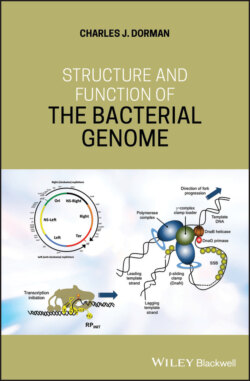Читать книгу Structure and Function of the Bacterial Genome - Charles J. Dorman - Страница 28
1.17 The Chromosome Has Looped Domains
ОглавлениеExamination of electron micrographs of thinly sectioned E. coli cells gives few clues as to the fine detail of chromosome organisation in the nucleoid. The images of chromosomes extruded from gently lysed E. coli obtained by Cairns (1963a,b) using autoradiography hint at a subdivision of the chromosome into looped, supercoiled domains. The nature of the domain boundaries was obscure but seemed to be associated with RNA (Kavenoff and Bowen 1976). Analysis with electron microscopy suggested that the chromosome was subdivided into between 12 and 80 supercoiled loops (Delius and Worcel 1974).
Sinden and Pettijohn (1981) used photobinding of trimethylpsoralen to intracellular DNA to estimate the number of independently looped domains. This agent binds to duplex DNA at a rate that is proportional to the superhelical tension in the DNA (Sinden et al. 1980). By estimating the number of gamma‐radiation‐induced nicks that were required to release most of the superhelical tension, an estimate of the number of topologically independent domains was obtained. For E. coli growing with a generation time of 30 minutes, it was estimated that the chromosome is divided into between 33 and 53 independent domains (or between 90 and 150 domains per nucleoid) (Sinden and Pettijohn 1981). The existence of independent domains is an important concept in nucleoid architecture: genes in one domain may be isolated from DNA topological changes taking place in other domains, making gene location along the chromosome significant for reasons other than differences in copy number arising as a result of gene distance from oriC.
More refined measurements of domain number in the E. coli chromosome or that of its close relative, Salmonella enterica serovar Typhimurium, have been made by exploiting site‐specific recombination reactions that can take place within but not between domains, by counting the number of looped domains in multiple images of extruded chromosomes, and by releasing superhelical tension from domains using restriction enzymes and observing the distance over which an effect on the transcription of a supercoiling‐sensitive gene can be exerted (Postow et al. 2004; Stein et al. 2005). The results from these experimental approaches indicate that the chromosome is subdivided into about 400 independent domains in E. coli cells during exponential growth, with each being approximately 12–14 kb in length. The boundaries between the domains do not seem to be fixed and fewer of them are found in bacteria that have entered stationary phase (Staczek and Higgins 1998).
